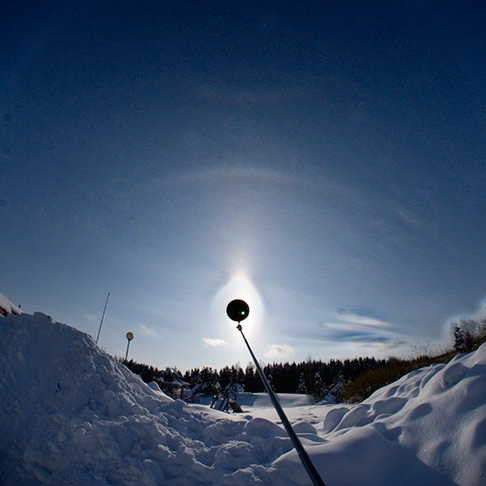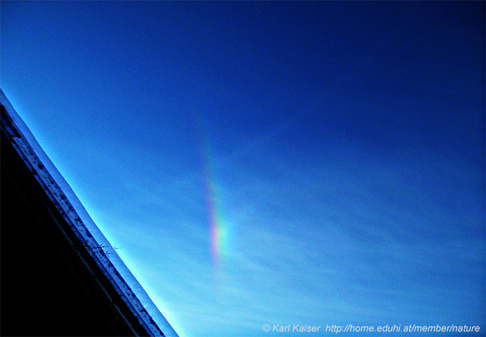Last January, 27 th, I managed to get one of my best halodisplays during my long observation period of halos - I have observed these phaenomena more than 15 years already.
On my way home from work I observed 14 different haloforms within 1 and a half hour (14:15 - 15:45 CET). It started with a bright circumzenith arc, sundogs and a clearely vertically elongated left hand side 120° parhelion on a short parhelic circle. Later the 120° parhelion on the right hand side appeared. The highlight (about 15:15 CET) was the observation of the CZA, supralateral arc, 46° halo, suncave and sunvex Parry arcs, upper tangent arc, 22° halo with sundogs, Tape arc, helic arc, subhelic arc and a little bit later a small part of the left infralateral arc.
I run a simulation with Halosim from L. Cowley and M. Schroeder that shows the halos I have observed near the sun quite good. A report and many images can be seen by clicking the image above. I invite you to take a look at the site.
Karl Kaiser
Sunday, 28 February 2010
Thursday, 25 February 2010
Peculiar 23° plate arc with an elliptical halo

The morning of 24th February at Riihimäki started with a solitary patch of supralateral arc ( 1 ) which was seen in a passing cloud and lasted for only a few minutes. Later on during the day a clearly elliptical glow could be seen in the vicinity of the Sun, and suddenly the glow started to have a defined shape: an elliptical halo. During the 2-3 minutes it took to gather photo gear and go back out was enough to lose the ring; the glow is all that can be seen in the 30 frame stack ( 2 ).
While the ellipse-stack was ongoing my attention was caught by two odd visitors: 23° upper plate arc and circumzenith arc. Immediately after change of lens the camera was grabbing images of that strange sight, see a 30 frame stack ( 3 ) and a 120 frame stack (taken with 3 second intervals, so total duration was about 6 minutes) ( 4 ).
The elliptical glow remained and sometimes seemed to have a true halo at its outer edge. The last two shots ( 5 - 6 ) show perhaps some kind of an ellipse, but it is hard to be confident since due to severe rush the images are not perfectly exposed and the 12bit sensor data is clearly in trouble because of the strong intensity gradient. Furthermore, the horrible dust of the lens spoils the images completely. Digital image processing methods, such as levels- and curves -adjustment and unsharp mask filter, are merciless regarding the cleanliness of the optical surfaces. Apologies for that.
During the ellipse - 23° plate arc - CZA -phase the sky was blue and snowflakes were floating down. The wind was not hard, but clearly noticeable and temperature in the ground was about -13°C. The halos seemed to be formed in an AC virga -type of "cloud", but the origin of the virga remained a mystery - there were no clouds seeding it. It is impossible to say whether the ellipse and the other halos were formed by the same cloud material or not. Some of the snowflakes were studied under microscope, but nothing peculiar was seen, just plain snowflakes.
On the 22nd of February Eetu Saarti managed to shoot a lunar elliptical halo in Tampere, whose duration was less than 30 seconds(!) ( 7 ).
Friday, 12 February 2010
Divergent light 22° halo on snow surface
The photo here shows divergent light 22° halo on snow surface in Eastern Siberia in January 1996. In airborne crystals divergent light 22° halo is a cigar-shaped surface, sometimes known as Minnaert's cigar, while on snow surface a slice of this cigar is seen. The illustration - made by Walt Tape - shows how the effect is formed. Lamp is on the right, observer on the left and in between is the cigar shaped 22° halo. The gray plane is snow surface and the red circle is the 22° halo on it. More images and illustrations are on my web site ( 1 ).
Marko Riikonen
Marko Riikonen
Subscribe to:
Posts (Atom)

